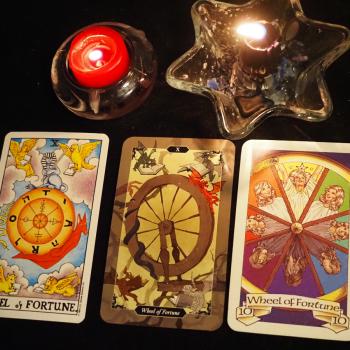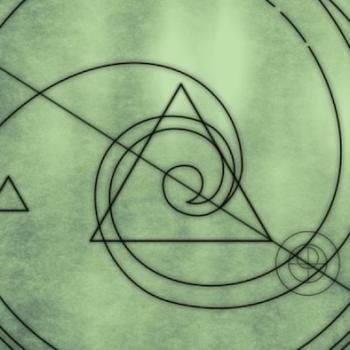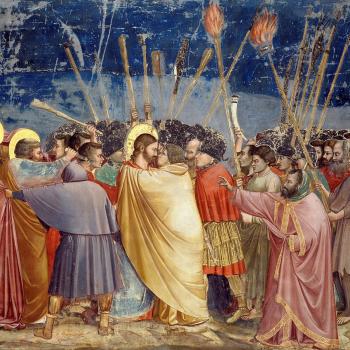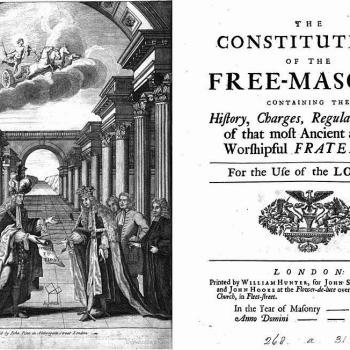Well, you asked for it …
There probably aren’t many pagans who have ever considered the Abramelin Operation, but it is something that nearly all will have heard of in some form. Whether it’s from the Abramelin oil or incense on the shelves of your local friendly occult shop, or the work of the Golden Dawn, MacGregor Mathers’ translation, elements of this grimoire have overshadowed pagan and occult works one way or another for 100 years.
But isn’t it Qabalah/Thelema/Christian/ceremonial/magick/delete as appropriate?
Yes, it’s probably all of those and a whole lot more – and it is time well spent taking a new look and identifying where we are missing opportunities to enhance our tradition, practice and devotion. If you want a balls-out devotional practice, hardcore, dedicate pagan initiation of the higher self as opposed to some namby-pamby, every other month paganism, then this might be where you find it.
Abramelin the Mage
The Book of the Sacred Magic of Abramelin the Mage includes within it all the classic grimoire tropes that we might expect to see, and we shall dismiss some of the assumptions with these to kick off. Firstly, the author paints himself as a Jewish mystic, with knowledge of Qabalah, extensively travels from Germany to Egypt in search of Truth and acquiring a breadth of knowledge that would make Elohim blush. He then proceeds to discuss sometimes distinctly Roman Catholic points, ritual prayer and evocation of demons which bear the hallmark of ancient pagan gods. Whilst it claims to be a Qabalistic work, it is expressly Goetic in its achievement, with a strong Theurgic element in its introductory purifications. Overall, the worldview that Abramelin suggests includes a breadth of syncretism that we would hope for in a learned magi, but retains a very goetic tone, including Lucifer, Ashtoreth, Belial and a host of pagan deities demonised.
Amongst the Hebraic names of the author’s family, it is interesting to note that the son to whom this work is addressed, the whole text being written in the style of a father’s advice to his son, is Lamech. This is relevant to us for a few reasons that are worth discussing briefly for those unfamiliar with witch lore, which claims its adherents descent from the lineage of Cain and the Fallen Angels.
The Biblical Tubal Cain is the seventh generation of the Cainite lineage and his father is Lamech. According to tradition, it is Lamech who slays Cain, under the direction of Tubal Cain who is demonstrating is newly created weapon, the arrow and bow. Strangely, this story emerges much later in Pagan northern European myths, preserved as a story about of the trickster god Loki and the Norse god of light Baldr. In this story, Baldr is invulnerable to harm from all the trees of the forest, except mistletoe, which Loki has fashioned into an arrow. The trickster then convinces Baldr’s blind twin, Hodr, to shoot his brother with the arrow and thus kills him (following which, he is subsequently resurrected). Nevertheless, we have here reference to the family of Cain, which is a prominent tutelary figure in the Craft sodalities and incumbent mythologies. 
The Great Beast and Beyond…
The Abramelin Operation was something that Aleister Crowley determined to perform, and indeed claimed to have done so. Crowley is supposed to have adapted the Abramelin Operation in order to perform it whilst travelling with his wife in China. A reader of the text might find this unacceptable, as the prescriptions and instructions demonstrate a committed, almost monastic, approach rather than making it fit around the things you want to do. That being said, the text does allow some relaxation of the overly restrictive elements. Nevertheless, Abramelin informed Crowley’s burgeoning religion a great deal and it became incumbent amongst adepts within the AA to attain the Knowledge and Conversation of the Holy Guardian Angel, which is achieved at the climax of the Abramelin Operation during the seven day rite.
Die and be born into me
One feature of the Abramelin which is significant is the ritual death and rebirth which marks all initiation rituals in the mystery traditions. The death and resurrection ritual is attained after a gruelling regime of devotion and ritual prayer, during which time the adherent dedicates themselves through more and more intense observations and prescriptions. This becomes nothing short of a ritual initiation and, indeed, the fruition of the Operation confers authority in the adherent over the infernal demons.
In previous posts we have explored the meaning and purpose of Lady Day within Traditional Witchcraft, being a birth, death, rebirth festival par excellence, as well as marking the commencement of the New Year. Significantly, the Abramelin Operation commences at the spring Equinox, aligning the themes and purpose perfectly well with the conception of the Christos and the increase in light, being at first a rite of fertility, later becoming one of vitality, concluding in inspiration. These three phases are highlighted deliberately as they are identified as the necessary purpose of magical ritual in the cache of Robert Cochrane letters (Monmouth, 2012), allegedly written by the ‘Old Man of Westmoreland’ (a mysterious figure who supposedly conveyed the essence of Witch lore an practice to Cochrane).
The rites are divided into three major parts, and these three parts must be followed in all magical practice… It begins with a fertility ritual, from there graduates into a ritual of Vitality, in which opposite poles of manifestation are brought into being, and then it takes the form of inspiration… One creates a temple physically, then mentally, then spiritually. (Monmouth, 2012)
The entire passage of this particular letter, designated Document B2 Magical Purposes & Dances in Genuine Witchcraft is Explained (Monmouth, 2012), pays comparing, but is too lengthy to reproduce here. In it, the letter writer describes building the temple and the need for incorporating this into your daily life, through humanity and the virtues: “You can create the temple by your own life but the Inhabitant will only come of Her own accord…”. In later writings to Oxford Cunning Man Norman Gills, Cochrane explains that all ritual must invoke the Three Mothers. Therefore, the Abramelin Operation conforms perfectly well to our pagan mysticism.
During the Vernal Equinox, the Abramelin Operation is begun and the period of fertility is engaged as the increase in seasonal light, analogous to the divine light of the logos, conveys its heavenly essence to the earth, rendering it, and us, fecund. As the sun attains to its height in the heavens, the mood shifts to vitality, being the strength and vigour of the solar zenith at Midsummer, reflected in the second phase of the Abramelin whereby the will is asserted in strengthening of the ritual occurs. Finally, in the last vestiges of the sun’s rays as its journey begins its descent into the west, we arrive at the point of equal night and day and the solar initiation reaches its inspirational period. During this phase, inspiration occurs as the adherent’s tutelary spirit, HGA, head Orisha, emerges and makes communications known.
The timing of Abramelin, then, coincides excellently with a ritual of these three potent energies which work from Kether to Malkuth, that is spirit into matter, then worked gradually up again to the point of inspiration. This very philosophy is described in the cache of letters pertaining to the Cochrane tradition (Monmouth, 2012). As the Autumn Equinox heralds a return to the Land of Nod(es), the celestial abode of the spirit moves closer as the underworld entrance looms with the gaping maw of the mound. It is apt, then, that the energies of the sun which have been accumulating as the Operation intensifies, result in that tutelary spirit contact at the curtain close of the year.
Once again, there are undoubtedly grumblings from many camps objecting to the use of Abramelin as a means of inducting the pagan through devotion to the tutelary genius of the celebrant. However, it is not without pagan underlying mysteries and, through careful adaptation, it is not without its devotional aspect. Indeed, for the most part, Abramelin presents the pagan an opportunity to strengthen their devotional praxis and incorporate daily morning, evening and (eventually) noon orisons, as well as connecting with those spirits which may guide and teach, as well as confer familiars. In addition, the origins of Abramelin must surely lie in the hoary Mystery schools that pervaded the West before the new Christian mystery tradition became heavily politicised and a means of subjugating an empire.
Dark Night of the Soul
It has been remarked by some that Abramelin is a ‘last chance’ ritual, implying that it is something that should be undertaken when all else has failed. While paganism is gaining its maturity in the west, it is without question that there will be those who experience periods of spiritual doubt, feeling disconnected and suffering a sense of loneliness at the realisation of the unknowable nature of divinity. The weight of this can cause us to sometimes doubt our path and it would be a fallacy that this would not occur within paganism. Indeed, the Abramelin Operation finds stark comparison to the ‘Dark Night of the Soul’, found in the work of the same name by John of the Cross, as well as the Ascent of Mount Carmel, and the anonymous medieval Cloud of Unknowing. In this instance, again three phases of purgation are described whereby the soul experiences purification of the sense, purification of the spirit and finally unto mystica. These three phases once again correlate with the magical technique requirements of feritility, vitality, inspiration. Still, as pagans, we can make use of these themes and mythic techniques of achieving higher consciousness in our own work.

Bringing it home again
The underlying concept of The Book of Sacred Magic of Abramelin the Sage is that of developing a relationship with your Guardian Angel. If you are at all familiar with Santeria, then you may be aware of the process of bringing down your guardian angel. In Santeria your Guardian Angel is one of the Orishas.
(from Art Of The Root boutique new age shop blog over at their lovely website)
Abramelin, with its Talmudic, Qabalist, Catholic, Magic influences certainly draws from older and related pagan spiritualities and sups from the well of the perennial philosophy in its function and form. That it is closely related to Hoodoo, Santeria, Obeah and African diaspora traditions does not, actually, surprise. The oldest extant manuscripts that deliver this text to our time date to around 1608 CE, all others date after these. It is thought that the Abramelin is much older and it gives a date for its composition as 1458, although that could be a fabrication for authenticity and authority of age. Aside form the authoritative German manuscripts of the oldest date, the book was printed in other languages, including French, which S. L MacGregor Mathers translated, suggesting it had been available on the continent.
However, it is generally agreed that the Abramelin technique is authentic and traditional, meaning that it has the hallmarks of a legitimate initiatory working to attain a spiritual teacher and guide at its heart. That the author indicates his knowledge of the operation originating with a hermit living on the banks of the Nile, close to Nag-Hammadi, is too tantalising to dismiss; although, we must regard as speculation any suggestion of Gnostic influence. More likely, we can see in Abramelin, by comparison to African derived religious ritual, the continuation of a far older shamanic ritual purification and ritual congress with spirits, in particular of a personal and tutelary nature. If we remove the Christian, Jewish, angelic veneers that bely the religious context of the day, we have the bones of a technique that legitimately engages the “other” directly and viscerally, whilst enduring a period of ritual observance that allows us to develop a relationship with that ‘other’. Indeed, lengthy periods of ritual prayer, fasting, purification and abstinence are typical of shamanic traditions prior to ceremonial communion with spirits.
The full rite and marriage of Spring falls in the last 1/4 moon in April, the May feast is a wedding breakfast… – Robert Cochrane (Monmouth, 2012)
It all starts at the Vernal Equinox. So, if you’re looking for that rite that might just supercharge your pagan mysticism and install your tutelary spirit in your head, Abramelin might be the one for you. Or you could go mad.
Monmouth, J. of. (2012). Genuine Witchcraft is Explained. Capall Bann Publishing



















